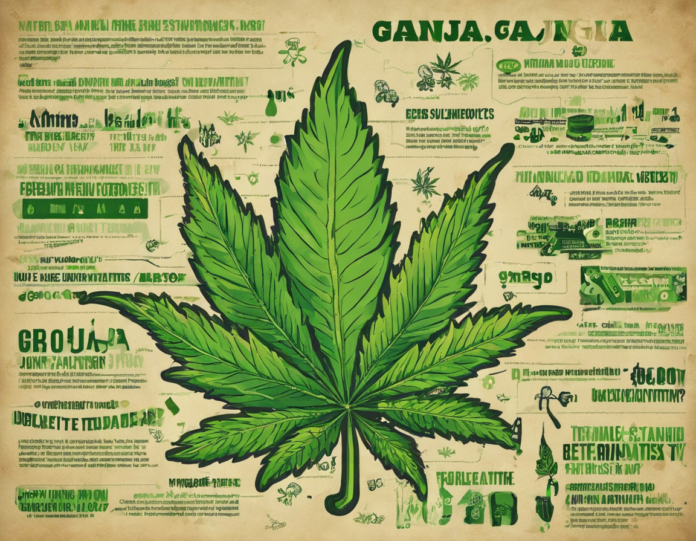Today, ganja is a widely discussed topic due to its legalization in various parts of the world. Ganja, also known as marijuana or cannabis, has been used for medicinal, recreational, and spiritual purposes for centuries. However, there is still a lot of confusion and misinformation surrounding this plant. In this comprehensive guide, we will delve into the various aspects of ganja, including its history, uses, effects, strains, consumption methods, and legal status.
History of Ganja
Ganja has a long history dating back thousands of years. It is believed to have originated in Central Asia and has been used for its medicinal and psychoactive properties in different cultures around the world. In ancient India, cannabis was considered one of the five sacred plants, and it was used in religious ceremonies and rituals. In China, cannabis was used for both medicinal and textile purposes. Cannabis eventually made its way to the Middle East, Africa, Europe, and the Americas through trade and exploration.
Understanding Ganja: Components and Effects
Components of Ganja
Ganja contains over 100 different chemical compounds known as cannabinoids. The two most well-known cannabinoids are tetrahydrocannabinol (THC) and cannabidiol (CBD). THC is the psychoactive component of ganja responsible for the "high" sensation, while CBD is non-psychoactive and is known for its potential medicinal benefits.
In addition to cannabinoids, ganja also contains terpenes, which are aromatic compounds that give the plant its unique smell and flavor. Terpenes may also have therapeutic properties and can interact with cannabinoids to produce various effects.
Effects of Ganja
The effects of ganja can vary depending on the strain, potency, consumption method, and individual tolerance. Some common effects of ganja consumption include:
- Euphoria: Many users experience a feeling of happiness and relaxation when consuming ganja.
- Increased sensory perception: Ganja can heighten sensory experiences such as taste, touch, and sound.
- Altered perception of time: Time may feel like it is passing more slowly or quickly when under the influence of ganja.
- Increased appetite: Often referred to as "the munchies," ganja can stimulate appetite.
It is important to note that ganja affects each individual differently, and some people may experience adverse effects such as anxiety, paranoia, or impaired coordination.
Types of Ganja Strains
Indica vs. Sativa vs. Hybrid
Ganja strains are often categorized as Indica, Sativa, or Hybrid based on their genetic characteristics and effects. Indica strains are known for their relaxing and sedating properties, making them ideal for nighttime use or for relieving anxiety and insomnia. Sativa strains, on the other hand, are uplifting and energizing, providing a more cerebral and creative high. Hybrids are crossbreeds of Indica and Sativa strains, offering a combination of both relaxing and uplifting effects.
Popular Ganja Strains
- OG Kush: A classic Indica strain known for its earthy and citrus aroma.
- Sour Diesel: A Sativa-dominant strain with a fuel-like smell and energetic effects.
- Blue Dream: A Hybrid strain that balances relaxation with cerebral stimulation.
Each strain has its unique combination of cannabinoids, terpenes, and effects, so it's essential to experiment to find the strains that work best for you.
Methods of Consuming Ganja
Smoking
Smoking ganja is one of the most common methods of consumption. It involves inhaling the smoke produced by burning dried ganja flowers. Smoking provides quick onset and allows users to titrate their dosage easily. However, smoking can irritate the lungs and may not be suitable for individuals with respiratory issues.
Vaping
Vaping involves heating ganja at a lower temperature than smoking, which releases cannabinoids and terpenes into a vapor that is inhaled. Vaping is considered a safer alternative to smoking as it produces fewer harmful byproducts. It also allows for precise temperature control, resulting in a more customized experience.
Edibles
Edibles are food and beverage products infused with ganja extracts. When consumed, the ganja is metabolized by the liver, producing a more potent and prolonged high compared to smoking or vaping. It is essential to start with a low dosage when trying edibles as the onset of effects can be delayed, leading some users to consume more than intended.
Topicals
Ganja-infused topicals such as creams, lotions, and balms are applied to the skin and absorbed locally. These products are popular for their potential pain-relieving and anti-inflammatory properties without producing psychoactive effects. Topicals are an excellent option for individuals seeking localized relief without the high.
Legal Status of Ganja
The legal status of ganja varies significantly from country to country and even within different states or provinces. In some places, ganja is fully legalized for both medicinal and recreational use, while in others, it remains illegal or decriminalized. It is crucial to be aware of the laws and regulations regarding ganja in your area to avoid any legal implications.
Ganja and Health
Medicinal Uses
Ganja has been used for medicinal purposes for thousands of years and has shown promise in treating various health conditions. Some common medicinal uses of ganja include:
- Pain relief: Ganja has analgesic properties that can help alleviate chronic pain.
- Anxiety and depression: Some individuals find relief from symptoms of anxiety and depression with ganja use.
- Nausea and vomiting: Ganja can help reduce nausea and vomiting, particularly in cancer patients undergoing chemotherapy.
Potential Risks
While ganja has medicinal potential, it is not without risks. Prolonged and heavy use of ganja can lead to dependency and adverse health effects. Additionally, ganja use may not be suitable for individuals with a history of mental health disorders, pregnant or breastfeeding women, and adolescents.
Frequently Asked Questions (FAQs)
1. Is ganja the same as hemp?
No, ganja and hemp are different varieties of the cannabis plant. Ganja refers to cannabis strains with high THC content used for recreational and medicinal purposes, while hemp has negligible THC levels and is primarily used for industrial purposes.
2. Can ganja help with sleep?
Indica strains of ganja are known for their relaxing and sedative effects, making them potentially helpful for sleep issues such as insomnia. However, individual experiences may vary.
3. What is the endocannabinoid system?
The endocannabinoid system is a complex network of receptors found throughout the body that are involved in regulating various physiological processes, including mood, pain sensation, appetite, and memory. Ganja interacts with the endocannabinoid system to produce its effects.
4. Can ganja be addictive?
While ganja is not physically addictive like substances such as nicotine or opioids, some individuals may develop a psychological dependence on it. It is essential to use ganja responsibly and in moderation.
5. How long do the effects of ganja last?
The duration of ganja effects can vary depending on factors such as dosage, consumption method, and individual metabolism. Generally, the effects of smoking or vaping ganja may last a few hours, while edibles can produce effects that last 4 to 6 hours or longer.
In conclusion, ganja is a complex plant with a rich history and a myriad of uses. Whether you are interested in its medicinal properties, exploring different strains, or simply curious about its effects, understanding ganja is essential for safe and enjoyable consumption. Remember to consume ganja responsibly, be aware of legal regulations in your area, and consult with a healthcare provider if you have any concerns.

